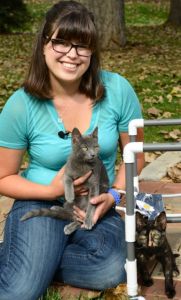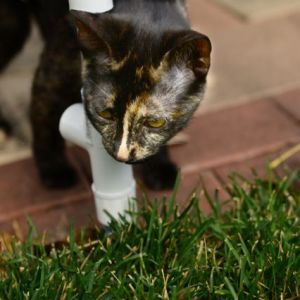Like many kittens, Creature and Jane tumble and stumble – but they have severe incoordination resulting from a brain disorder that their owner, Hannah Turner, says could have been avoided.

“It’s such poignant example of why vaccines are so important,” said Turner, a Colorado State University veterinary student.
The kittens were born with cerebellar hypoplasia, a neurological disorder caused by an underdeveloped cerebellum. Because the cerebellum controls coordination and fine motor skills, cats with the disorder are commonly referred to as “wobbly cats,” identified by their “drunken sailor” walk.
The cerebellum growth was stunted in utero when the mother cat contracted feline panleukopenia virus, or feline distemper, a highly contagious viral disease that can be prevented with vaccination.
Turner rescued the kittens from certain euthanasia after learning about the brain disorder during a CSU veterinary neurology class. She decided to adopt in an effort to help; in the course of intensive physical therapy and support for her disabled kittens, Turner has become an ardent advocate for vaccinations.
“Kittens like this that end up in a shelter are likely euthanized because they require a lot of special attention,” Turner said. “Taking these kittens in was my chance to make a difference and give them the best chance they’ve got.”
Dr. Michael Lappin, a CSU veterinarian and professor of infectious disease, said the vaccine that protects against feline distemper – and averts cerebellar hypoplasia in kittens – is recommended at age 6 to 8 weeks, followed by lifelong boosters.
“The brain disorder can be avoided in the large majority if the mother cat is well vaccinated before pregnancy,” Lappin said.
A happy, healthy future
Despite their underdeveloped brains, Creature and Jane have the potential to live happy, healthy and long lives with Turner’s help.

“Aside from missing part of their brains, they are just like any other cat, but it’s definitely a partnership with these kittens,” Turner said.
She provides the disabled kittens with help they need feeding and using the litter box. And, on top of her busy school schedule, Turner provides physical therapy for the little cats three times a day. She even designed a walking cart with a harness, allowing the kittens to simulate normal walking.
“I’ve been working with the Veterinary Teaching Hospital’s physical therapist to design a plan that may help Creature and Jane better compensate for their disabilities,” Turner said. “There isn’t any research published supporting that physical therapy is effective in helping cats with cerebellar hypoplasia, but we can only hope.”
Turner has created social media pages and a YouTube channel to track her journey with Creature and Jane. She hopes to raise awareness of cerebellar hypoplasia and preventive measures.
“Feline distemper has real consequences to both the infected cat and her unborn kittens,” Turner said. “Creature and Jane’s story speaks to the body’s amazing ability to compensate while also serving as a visual reminder of why vaccines are important.”
Preventable diseases
The American Veterinary Medical Association identifies eight cat diseases that can be prevented with vaccination and deworming:
- Rabies
- Feline panleukopenia, or feline distemper
- Feline herpesvirus infection
- Feline calicvirus infection
- Feline leukemia (FeLV)
- Feline immunodeficiency virus (FIV) infection
- Heartworm disease
- Intestinal worms